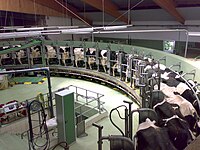
Photo from wikipedia
The growth rate hypothesis posits that the rate of protein synthesis is constrained by phosphorus (P) supply. P scarcity invokes differential expression of genes involved in processing of most if… Click to show full abstract
The growth rate hypothesis posits that the rate of protein synthesis is constrained by phosphorus (P) supply. P scarcity invokes differential expression of genes involved in processing of most if not all elements encompassing an individual (the ionome). Whether such ionome-wide adjustments to P supply impact growth and trophic interactions remains unclear. We quantified the ionomes of a resource-consumer pair in contrasting P supply conditions. Consumer growth penalty was driven by not only P imbalance between trophic levels but also imbalances in other elements, reflecting complex physiological adjustments made by both the resource and the consumer. Mitigating such imbalances requires energy and should impact the efficiency at which assimilated nutrients are converted to biomass. Correlated shifts in the handling of multiple elements, and variation in the supplies of such elements could underlie vast heterogeneity in the rates at which organisms and ecosystems accrue biomass as a function of P supply.
Journal Title: Ecology letters
Year Published: 2020
Link to full text (if available)
Share on Social Media: Sign Up to like & get
recommendations!